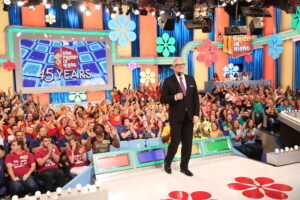Despite All of TV's Changes, Millions Still Think The Price Is Right
People who work in, invest in and write about technology and entertainment, like me, tend to get routinely distracted by the latest skinny bundle, disruptive business model or curated digital media channel to bounce into view.But it's important to remember there's another entertainment business out there that, yes, is in the middle of being disrupted. But it's also still huge. And it's still making lots of money, attracting lots of eyeballs and slowly trying to accommodate the complications of social media and digital broadcasting and all the rest that now affect its business.
With that in mind, I spent the better part of a day recently at a taping of the venerable CBS game show "The Price is Right," hosted by Drew Carey and produced by Fremantle Media in the network's Television City facilities in the heart of Los Angeles.
At 45 years old, "Price" is the longest running game show on television. It is older by far than many of its fans, whose demographics stretch from 20-something Millennials to retirees, male and female, and, based on the audience I saw, every race or ethnic group willing to don garish T-shirts in the hope of getting picked to "come on down."That wide-ranging fan base keeps the show No. 1 in daytime, even as the TV industry's audience demographics continue to age. The "Price" fan base remains ardent for a couple of reasons, I think.
Mills' prize-management team of 16 has several duties, from scouting for hundreds of attractive goods and experiences to acquiring them (through purchase, tradeouts or promotional giveaways) to warehousing and fulfillment, including handling the legal and tax issues and getting those prizes to winners.The prizes on offer have changed substantially over the years, as the show has tried to keep current with consumer trends. Mills jokes that "the 1980s (prizes) were all about grandfather clocks and sewing machines." In an era of fast fashion when many don't even wear watches, grandfather clocks and sewing machines were no longer hot.Every January, Mills and his team scout the Consumer Electronics Show for the year's hot devices to come. The taping I watched featured a PlayStation 4 game console, PS VR virtual-reality headset, a couple of VR games and other accessories. Electric scooters, smartphones, audio gear and 3-D printers now are among the other offerings.And because "Millennials don't want just stuff, they want experiences," the prizes now include more vacation trips and "nights out" with dinners, movie tickets and more, and kitchen appliances that come with subscription boxes filled with meals to make.All that material is tracked through a vast database built on Pilotware software that records details about every prize, every contestant, what they won and more. And if, as occasionally happens because of tax implications or other reasons, a winner declines to take their prizes, that goes in the database too, and that winner won't be eligible to compete again on the show.
 On the mid-March day I visited, the show was taping two episodes for its annual "Socially Awesome Week" of promotions, all to run this week. The first day of Socially Awesome Week featured former Vine star Jake Paul taking over the site's Instagram feed, and working as a model displaying prizes during the telecast.The presence of Paul, brother of Logan and himself possessed of more than 5 million Instagram followers and 3.6 million YouTube subscribers, is an example of the show's creators trying to keep pace with technology and culture."We used to have to come out and ask the crowd about the prizes they liked and the games they liked," said executive producer Mike Richards of Fremantle. "What social media does is allow us to do that across the country, and have people pick the prizes we offer. We love it. We get such interaction."
On the mid-March day I visited, the show was taping two episodes for its annual "Socially Awesome Week" of promotions, all to run this week. The first day of Socially Awesome Week featured former Vine star Jake Paul taking over the site's Instagram feed, and working as a model displaying prizes during the telecast.The presence of Paul, brother of Logan and himself possessed of more than 5 million Instagram followers and 3.6 million YouTube subscribers, is an example of the show's creators trying to keep pace with technology and culture."We used to have to come out and ask the crowd about the prizes they liked and the games they liked," said executive producer Mike Richards of Fremantle. "What social media does is allow us to do that across the country, and have people pick the prizes we offer. We love it. We get such interaction." Day 2 is another example of harnessing new technologies to connect more closely to far-flung fans. Two people submitted winning videos of what they would do if they were invited to "come on down." The winners were flown in by the show and put up in a Los Angeles hotel for the night so they could take part.One of the two "Tweet for Your Seat" winners is Krystal Roberts, an art-school graduate and candy-store stocker from Chicago.Her winning video, shot by her mother, shows Roberts lying on a couch, wearing a cast on her leg. When "told" to come on down, she throws aside her crutches and icepack and runs out the door, yelling that she's on her way and will be at the show in seven days."We're capitalizing on where our audiences are," said Richards. "The videos are fun and funny. We would love to travel the show, to be in a different city every two weeks, but we can't really do that. So (this is) more of that initiative of touching our fans (through social media) and getting them to be part of the show."Her Tweet for Your Seat video won Roberts a seat in the audience. Getting up on the stage was a different, and decidedly more complicated, process altogether.
Day 2 is another example of harnessing new technologies to connect more closely to far-flung fans. Two people submitted winning videos of what they would do if they were invited to "come on down." The winners were flown in by the show and put up in a Los Angeles hotel for the night so they could take part.One of the two "Tweet for Your Seat" winners is Krystal Roberts, an art-school graduate and candy-store stocker from Chicago.Her winning video, shot by her mother, shows Roberts lying on a couch, wearing a cast on her leg. When "told" to come on down, she throws aside her crutches and icepack and runs out the door, yelling that she's on her way and will be at the show in seven days."We're capitalizing on where our audiences are," said Richards. "The videos are fun and funny. We would love to travel the show, to be in a different city every two weeks, but we can't really do that. So (this is) more of that initiative of touching our fans (through social media) and getting them to be part of the show."Her Tweet for Your Seat video won Roberts a seat in the audience. Getting up on the stage was a different, and decidedly more complicated, process altogether.The man in charge of deciding who gets to "Come on down" is Co-Producer Stan Blits, who has worked on the show for 38 of its 45 years. For the past 13, he has been the person winnowing through the audience to find contestants, a process that begins outside the studio where audiences are staged in a covered outdoor area.Blits and his discreetly hovering assistant work the line, talking to groups of about 50 audience members at a time. In this part of process, Blits functions somewhere between casting agent and stand-up comedian, loosening up audience members but also sizing them up as prospective contestants.In his patter with each person, he gauges whether they have the requisite energy, presence and perhaps quirky personality to pop onscreen and add to the show's entertainment value. When Blits finds a good one, he'll drop a code word to his assistant, who jots down the contestant's number for further review.
Later, Blits and the show production team lay out sheets featuring large photos and other information of each candidate contestant, shuffling through and stacking a purposely diverse mix of possible players."You gotta love everybody that comes up there," Blits says of the mix he's seeking, built on the briefest of interactions. "I've seen people win $10,000 and completely flatline, or they do a golf-tournament clap," he says, miming a tepid pat of hand on hand.After doing a mid-show "adrenaline check" of remaining prospects, Blits may further shuffle his contestant mix."I talked to the show director and he said we could get some age up there," he says.Accordingly, the next contestant called down is a portly, beaming white man in his late 60s wearing a red shirt that reads "I flew all night for The Price Is Right."On this day, two of the prospects are a "bit of a risk." Their quirky behavior in the line might translate wonderfully onstage, or they could freak out once they're on camera and no longer anonymous, Blits says.One of the "risks," a matronly African-American woman who was twerking and boisterously interacting with others in line, makes it onstage in the show's second half. She wins, and wins again, emoting heavily and amusingly throughout. After her second win, she sprawls on a step on stage, seemingly wrung out by the adrenaline rush."It worked," Blits says. Making the woman a contestant "paid off."
Roberts also ends up getting picked as a contestant, and through a somewhat unlikely series of events, ultimately wins the episode's top prize, trips to China and Switzerland, and smartphones to take pictures of it all. But her excruciatingly long process of making a final, winning bid caused one control-room operator to crack that Roberts was "The Decisive Contestant."Through it all, there's the host. For the past decade, it's been Drew Carey, famously a champion of his native Cleveland and a stand-up comedy veteran who had his own hit sitcom and another improv TV show before taking over for the iconic Bob Barker.When I meet with him backstage between episodes, Carey is genial and low-key.Unlike the show's producers, who are pushing the show into a wide variety of social media platforms and gimmick activations especially during Socially Awesome Week, Carey says social media hasn't been a big priority for him."I have the same followers as I did when I started," he said. "I like to keep in touch with the fans. That was the plan."He talks about getting back into standup during hiatus, but also acknowledges that's a very different, and very difficult life from hosting "The Price is Right." A recent trip with a buddy down to the Orange County headquarters of video game company Blizzard Software reminded him of what's involved."We had a really good day at Blizzard," Carey said. Then, the buddy had to schlep back to Pasadena, a punishing rush-hour haul, because that night, he had to deliver 11 minutes at a comedy club, part of a three-times-a-week grind of writing new material, honing it and working the room before and after.Carey's reluctance to jump back into all that is palpable. His current gig is a far better one, and he certainly knows it. Meanwhile, he says, he's grown into the current job, becoming far more confident engaging with each contestant to get them to open up during their few minutes on stage. And it's those people that make the show."It's the people and the kinds of prizes they win," Carey said. "As long as there are people you can relate to, the show will be successful. The key to me is to see people you can relate to."And so "The Price is Right" juggernaut rolls on, updating itself in a thousand small ways, and yet seemingly far removed from the latest hot tech trend or digital media gyration. It's good to remember that sometimes.



